Winner of Best Pro Action Feature for the Artemis Women In Action Film Festival 6th Edition, and official selections for Beloit International Film Festival, Heartland International Film Festival, and Dances with Films Film Festival, Where We Disappear is an intensely and beautifully told story both visually and emotionally. It chronicles the lives of women inside a prison camp, taking us through the twists and turns as their indomitable spirits grow stronger and more determined with each offense. This is a movie about survival! And this is what they are saying about Where We Disappear.
“A beautiful and deliberate exploration of human resilience.” –Film Threat
“More tension than a wire fence.” –Byte
“This stays with you long after the curtain falls.” –Behind The Lens Online
About: After committing a crime to protect her son, Anastasia is sentenced to 12 years in a Soviet prison camp. Her arrival upsets the balance of power between the inmates. Georgina Haig; Jolene Andersen; Katharine Isabelle; Vera Cherny; Osa Wallander; Arthur M. Jolly, writer; Simon Fink, director; Vanessa Pantley, producer. Adult themes. USA
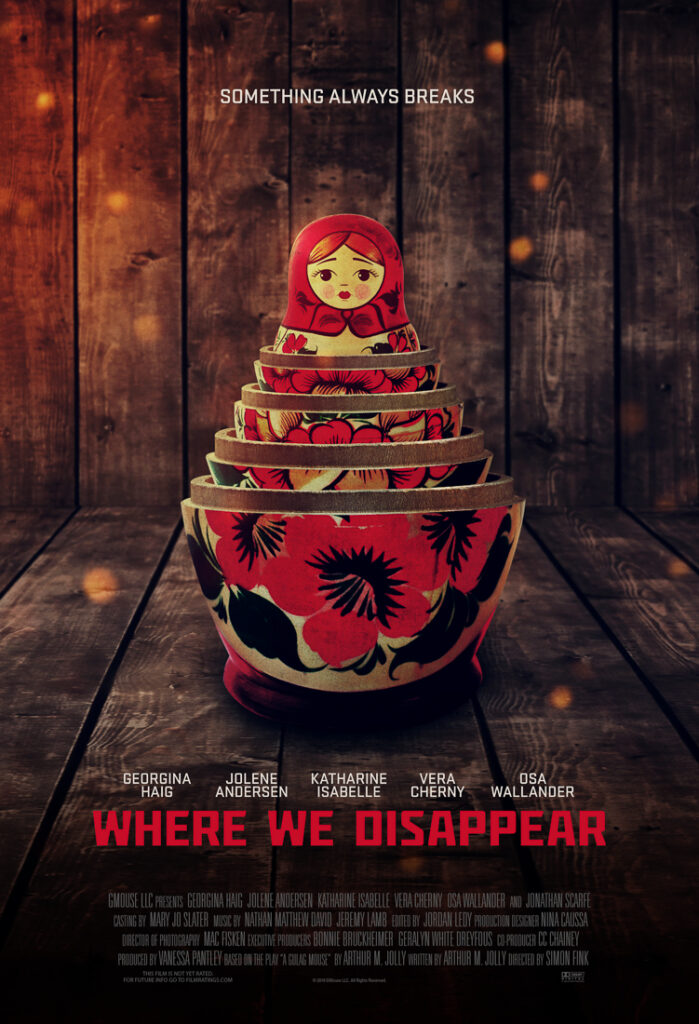
Interviewed by Kaylene Peoples
Responses by Simon Fink, Director
Tell me about your Where We Disappear and your inspiration for making this film.
It began as a national award-winning play, A Gulag Mouse, that Vanessa Pantley (Producer) and I happened to see a local production of. We called each other the next day with the same excitement about adapting it for the screen. Vanessa is a talented producer, and ever since film school at USC, we had talked about one day collaborating. Here by accident had come an opportunity.
I made my way to the playwright (and the film’s screenwriter) Arthur M. Jolly, who is an Academy-recognized Nicholl Fellow and pitched my take and enthusiasm.
At its core, Where We Disappear is a story of survival. Among the millions of victims of the Gulag labor camps, women were imprisoned for speaking out, for protecting their family, for saying “no” to powerful men— and that was only the beginning of their struggle. The story bridged my passions of activism and filmmaking. The challenge was then how to relate it to the cast and crew and explore it together.
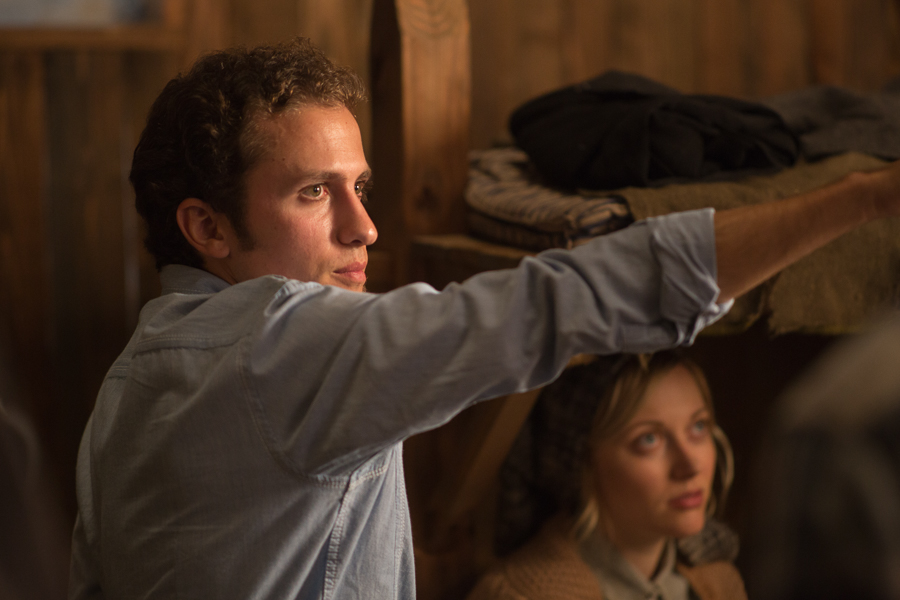
How long did it take to complete the film? What was it shot on?
We shot it in 14 days on the Red Scarlet Dragon.
What was your filmmaking process? Let’s talk about the cast and crew.
Many of the collaborators were people we’d worked with before or had known from college. My freshman roommate for example, by coincidence (not by my intervention), was the assistant director.
The cast became a family, even though their characters are at times trying to beat, choke, or stab one another. This is a performance driven film, and these five women (for the most part) have been imprisoned together for some time. It was important that they became comfortable with each other and with me, which is why we did a week of intense rehearsals before production.
Each of them has a different method for approaching their character, which I adapted to. Katie, who plays LUBOV, for example works off instinct, reacting in the moment. Osa, who plays SVETLANA, and I often discussed her character’s backstory to anchor her responses. Vera, who plays PRUSHKA, would draw from personal emotion and background (born in Russia). There were nuances to all their methods and it was both a challenge and a joy to switch between each one.
We found our goal of turning five strangers into five characters with histories and relationships, and the ability to take whatever production we threw at them. I especially enjoyed the bunkhouse production days, not only to see those performances in action, but to continue experimenting, especially as each variation in a take yielded something unique.
We did a group hug at the end of each day.
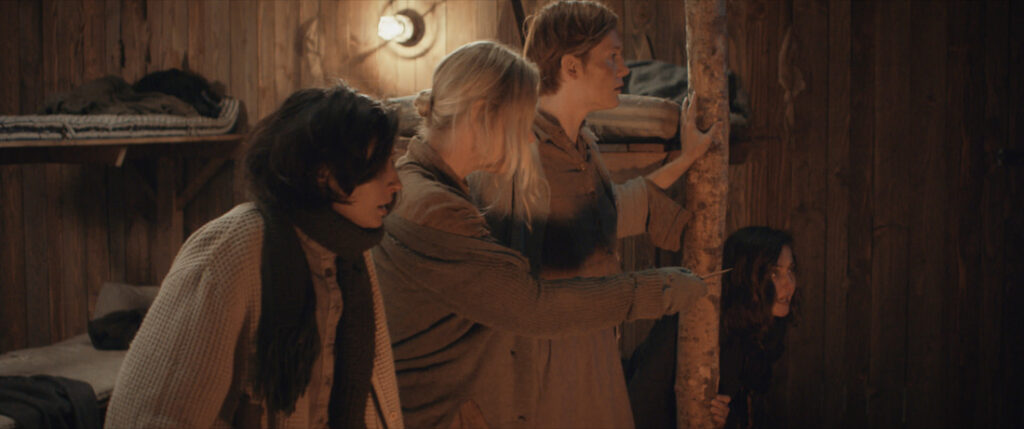
Tell me about who was involved and particularly your key players.
Every department was a key creative collaborator. There were two larger guides I maintained. One was the authenticity of the world. From the size of the rationed portions given to each character to the design of the camp in VFX, authenticity anchors us in a world that is largely unknown to American audiences.
The other relates to the twist at the end. So while we researched the history, we discussed with the departments how we could plant elements that support the ending’s reveal. Could production design add root-looking rope to the beams of the bunkhouse and add dirt to the corners to create a subtle feeling of being underground for example.
We also wanted the film to act like a visual funnel. We begin with the expansive shot of a forest at night and gradually get tighter as we get deeper into the story until we are locked up with these women in the bunkhouse. Once there, character movement within the bunkhouse followed its own set of axes. The corner with the stove is a place of power and fire, whereas the opposite corner is the coldest and weakest. The corner with the water and hanging clothes is calm and orderly, whereas its opposite corner is rarely seen and dark. The movement and hierarchy of the characters often organically follows these axes. At the most chaotic moment, for example, all the characters dive into that dark corner.
These guides are subtle but very much informed various scenes.
Vanessa Pantley led our all-women producing team. Her dedication and collaboration pushed the film forward and made it better at every angle.
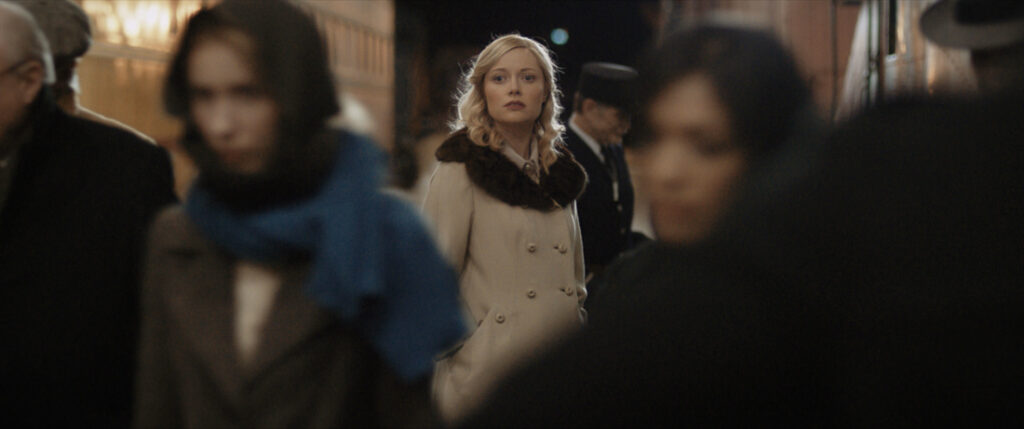
What was your experience on Where We Disappear? What drew you to this film?
I grew up in a community of survivors. I worked with both Holocaust survivors and Lost Boys, resettled from Sudan to bring them to schools to speak. Whenever I heard their stories, I felt a need to share them, to bring the deepest core strengths and struggles within our nature to light.
In such an extreme place as the Siberian Gulag, what is the one thing each character draws strength from and how do they protect it? The question guided the actors and me through intense rehearsals before production. The answer became our foundation so we could walk onto set and tackle scenes with emotional truth. It also gave us room to “play” on set, unusual as that sounds for a prison camp, and try variations in each take.
A survivor’s lifeline — that discovered raw core that keeps one from breaking – and our crew’s commitment through details and rehearsals all aim to make this story relevant. Pair that with a psychological twist and we have a film worth sharing.
What were some of the most memorable moments on set?
Because production is such an intense spinning rush, the most memorable was when it stopped. Wrapping our last day of principal photography in the early morning on Mt. Baldy, I took a moment to exhale, to say to myself, “we did it.” Of course there was the whole long post-production, festival submissions, etc. after that, but I remember holding that moment.
As a filmmaker, tell me about your background.
My drive as a storyteller has never shifted. At age 14, I shot and edited a short piece on the homeless in Cambridge, Mass., for which I received the Inspirational Award from the national SOL Film Festival— its youngest recipient. I realized that a storyteller without an audience is either practicing or crazy. I can touch people.
My writing and filmmaking has often dovetailed too with my long-standing interest in human rights and survivors of genocide. It gives me an opportunity to share stories that can affect change.
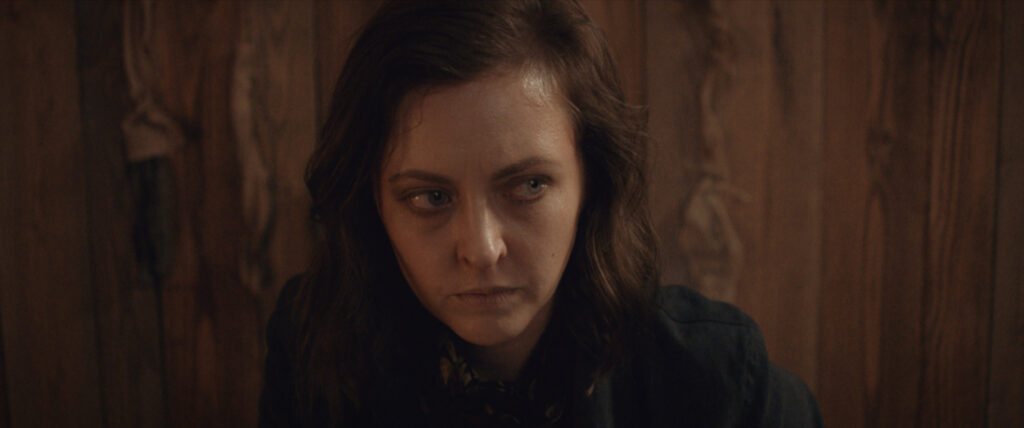
What would you say is unique about this film?
It’s an emotional film, but it’s also a thinking film. It has the kind of psychological twist that makes watching a second time a different experience once you know that these women are all part of the same person – the parts of ourselves we sometimes don’t even recognize that help get us through the toughest situations.
It’s also the only film I know that uses sand art for its opening credits. The art is done by Kseniya Simonova, the top sand artist in the world and winner of Ukraine’s Got Talent.
Were there any challenging moments during production?
The opening was a big challenge, because it required an old Soviet train interior, a train exterior passing through Russian countryside, and the train’s arrival at a train station. It was important for us to find a steam train that could pass as a Soviet 1945 locomotive. The countryside had to pass for Russia, preferably with snow. We put out feelers across the country and Canada for the moving train.
I was looking up train stations around Southern California when Google popped up a result ten minutes away in Griffith Park. Turns out there’s an old train museum right in the middle of the park that we never knew about. Not only did it have a great platform but we were able to use the antique interior of one of the trains as well.
As for the moving train, months into the search we found the friendly small town of Sumpter Oregon that operates an old locomotive. It had the perfect look and operates two days in winter for Christmas. The DP, Vanessa, and I flew up to Seattle. From there we drove six hours into the interior, the whole time worrying that we wouldn’t get any snow since it had been a dry season. A blizzard lost us our first day of filming. We managed to get everything we needed and when we returned home, we learned that that snow storm had been on the news. It’s called the “Siberian Express” when a mass of cold air crosses the Pacific from Siberia and dumps snow on the Northwest. So yes, we got real Siberian snow in the film.
What were some of the highlights of filming Where We Disappear?
The most rewarding were the scenes with the actors in the bunkhouse and seeing the reactions of the crew to their powerful performances.
What were some of the obstacles?
I wouldn’t call them obstacles so much as creative challenges. From a lead who was several months pregnant to very packed shooting days, we had to come together as a cast and crew to make it and be proud of the result.
On your next project what might you do differently and what might you do the same?
Differently? When it comes to the world of indie distribution, I think the landscape keeps changing even while we were going through it. It will require a different approach in the future, especially with what we’ve learned.
For the same, I would say rehearsals!
How has Covid19 affected your production/post if at all?
It certainly delayed our Artemis [Women In Action] Film Festival experience, but we’re very thankful to have returned with them this year.
What advice could you give to a first-time director/producer/composer/etc?
As my first feature, I learned a lot, particularly the balance between trusting one’s gut and listening to others. It affirmed the importance of creating an environment where people feel they can freely express concerns and ask questions.
Is there is anything else you’d like to mention. If so, please do.
Thank you for this opportunity!
-Simon Fink, Director
Visit Artemisfilmfestival.com. The festival is streaming till May 31st! Where We Disappear Social Media: Facebook & Instagram




